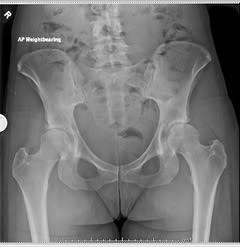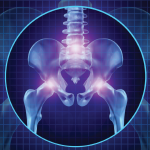
Moderate to severe osteoarthritis of the left hip.
What I learned from having a hip replacement at age 39
I was taller than most of the boys growing up, and to be frank, I still am. My dad encouraged me to sign up for all the co-ed sports teams (i.e., boys’ teams with one girl on the roster—me). I loved being an athlete. I played volleyball through high school and later became addicted to group fitness classes and hiking.
At age 32, I started bodybuilding, chasing strength and physique gains. So when I began waking up in the middle of the night with deep, left sacroiliac (SI) joint pain in my mid-30s, I blamed the deadlifts and overtraining. I brushed it off and pushed through.
By February 2023, I could no longer sit in a chair for more than five minutes without severe SI joint pain. I saw two chiropractors and a physical medicine and rehabilitation specialist—none of whom thought my spine was the issue. Concerned about the possibility of spondyloarthritis (SpA), I advocated for labs and radiographs of my SI joints, which were all normal.
I remember half-joking: “Wouldn’t it be wild if I missed my own SpA diagnosis?”
Physical Therapy
When all was said and done, I was prescribed gabapentin and left with more questions than answers. I started to lose faith in doctors and, instead, turned to a skilled physical therapist. She took one look at me and noticed that my pelvis was torqued out of alignment and internal rotation of my left hip was severely limited.
We made a lot of changes to my training routine, and I faithfully did my physical therapy (PT) exercises three times per day for months. I improved enough to complete a 52-mile hike through Chilean Patagonia. But shortly thereafter, acute anterior groin pain emerged.
In February 2024, I saw an orthopedist who ordered an MRI of my left hip and lumbar spine, which revealed an acute left labral tear, as well as severe osteoarthritis of the left hip. There was some mild facet arthropathy in my lumbar spine, but not much else. I was sent back to PT—again.
By this point, I was doing 20 minutes of PT exercises every morning just to function, and my life had shrunk. My five-day a week weightlifting routine and avid hiking hobby had dwindled down to barre class and walks, which I often had to cut short due to pain. I couldn’t sit on the floor, tie my shoes or roll over in bed to reach something on my nightstand without pain. My sex life was affected. I assumed I just wasn’t resting enough.

